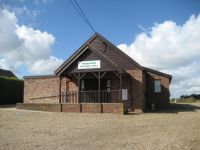


At the time of the conquest there were two Thorndon Manors. The first and main manor, Thorndon, was held by Wulfeva under the patronage of Stigand and consisted of three carucates which was equal to 40 acres of land; a carucate being a form of Danelaw tax which was based on the amount of land a team of eight oxen could plough in an annual season.
Thorndon was mentioned in the Domesday Book of 1086 and had a recorded population of 46 with livestock consisting of 31 pigs, 2 cobs, 15 cattle and 24 sheep. It had a church with 50 acres of free or common land with one plough and an acre of meadow.
By 1086 the Manor was held by the Norman, Robert Malet. In 1320 the Manor formed part of the dowry of Isabel, Queen of England and by 1337 ownership moved to Robert de Ufford who made his mark on the Manor by building All Saints’ Church.
By 1538 the Manor was in the hands of Charles Brandon, 1st Duke of Suffolk. Brandon was a favourite of Henry VIII and was rewarded with gifts of land; Thorndon being one of those gifts.

In 1615 James 1st granted the land to Sir John Prettyman who had been in possession of Hestley Hall since 1563. The last Lord of the main Manor was Frederick Hayward of Needham Market who sold the Manor in 1919 together with the Manor of Rishangles.
The Thorndon Town Estate owned land in Wetheringsett, Occold and Thorndon with some of the feoffments dating back to the Elizabethan age. In 1840 the Town Estate incorporated a workhouse, yard and cottage and 84 acres of land; rent and profits going towards church repairs and support for the poor.
From 1844 the land became sub divided; Thorndon had increased and whilst farming still played a large part with 16 farmers being recorded, other occupations bore witness to the village being a thriving community. The Chief Constable, Mr J Hayward, who was described as a gentleman of Stanwell Lodge was amongst a grocer/draper, a miller/grocer, two blacksmiths, two wheelwrights, two beer house keepers, a victualler, a tailor, bricklayer and two shoemakers. By 1912 these trades were joined by a pork butcher and poultry dealer, two more farmers and a police officer. The Post Office was in existence at this time and only ceased to trade in 2008.
In 1851 the population increased to 725 but by the beginning of the 20th century numbers had declined which was probably due to hardship in rural areas and the subsequent movement of population to the towns and industries. To get an idea of the working and living conditions of farm workers during 1942 watch a short film titled The Harvest shall come.
Small farms were bought to consolidate land into viable acreage and by 1981 554 inhabitants were recorded; today the population of Thorndon is over 650.
Recreation was recorded in 1844 as the two beer houses and The Black Horse Public House. By 1912 the Reading Room on High Street, a virtually all male establishment, also provided leisure activity. The daughters of Mr Robert Henry Lockwood complained to their father that there was no entertainment for them and around 1929 he bequeathed land to the village upon which the Village Hall was built in 1931.
 In the early 19th century, education was restricted to Sunday School, but by 1833 there was an infants’ school with 18 attendees and a day school with 20 children. The Kerrison Reformatory was established in 1856 in addition to a National School at Rectory Cottage (now The Reading Room) whereby 1d a week would be paid for each child attending tuition.
In the early 19th century, education was restricted to Sunday School, but by 1833 there was an infants’ school with 18 attendees and a day school with 20 children. The Kerrison Reformatory was established in 1856 in addition to a National School at Rectory Cottage (now The Reading Room) whereby 1d a week would be paid for each child attending tuition.
Today the village has The Black Horse Public House and the village 'community run' shop.
A comprehensive history of Thorndon was produced by a local author, Irene Theobald in 2012.
